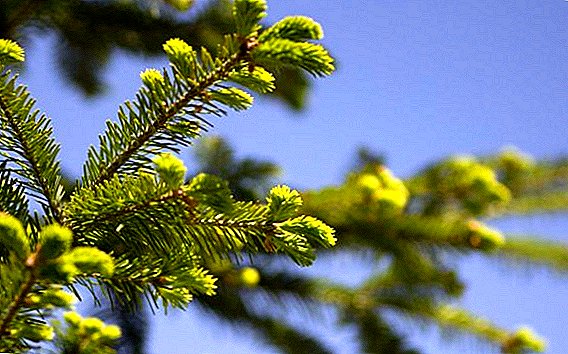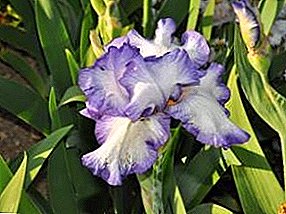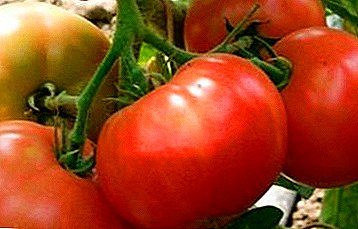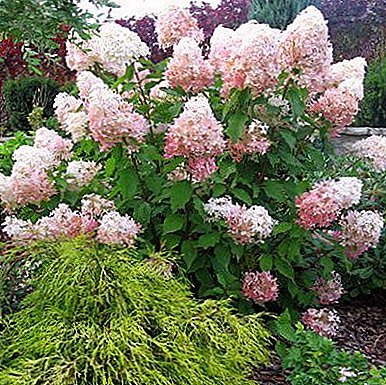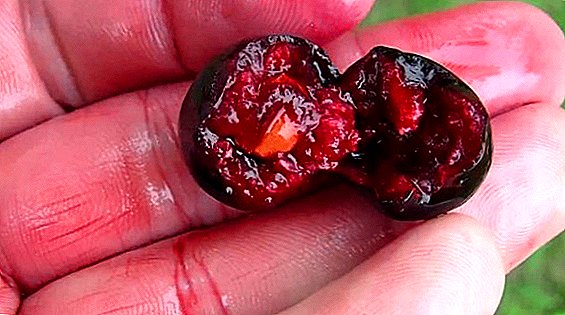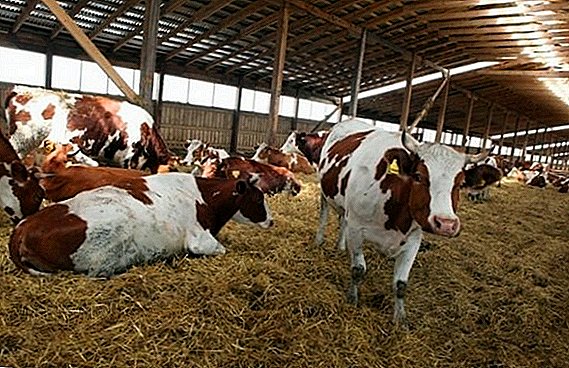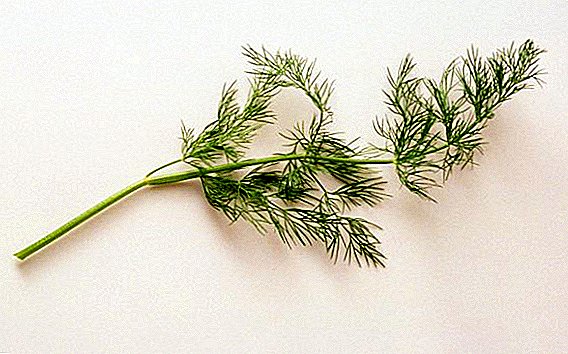 Dill, probably the most popular herbaceous crop grown in all parts of the world. Dill grows on all continents, with the exception of the poles. The grass is not whimsical and grows it not only in the open field, but also at home, like a pot in a container on the windowsill.
Dill, probably the most popular herbaceous crop grown in all parts of the world. Dill grows on all continents, with the exception of the poles. The grass is not whimsical and grows it not only in the open field, but also at home, like a pot in a container on the windowsill.
Early ripening varieties of dill
Early varieties of dill almost immediately after planting form umbrellas. These varieties are not very good for obtaining a large green hardwood mass. They are grown mainly for umbrellas and stems, which are used in conservation. Growing early ripe varieties, at the end of spring, you can please yourself and your relatives with fresh fragrant greens. Early varieties begin to sow in March. In this article we will talk about dill, its most popular types and varieties.
Did you know? The first written mention of dill, scientists have found in Egyptian papyrus. When going on a trade trip or as a military campaign, the Egyptians took dill with them. Over time, seasoning settled down in Palestine and Greece, even came to Rome. Although there, unlike the Egyptians who eat dill for food, they decorate houses because of the aroma, weave wreaths, awarding them philosophers, orators, winners of various competitions.
 Grenadier. The variety has a dense and high leafy rosette. The leaves are characterized by large segments, juicy and fragrant, emerald colors. The height of the stem to thirty centimeters. Dill greens ripen within thirty days from the beginning of planting, umbrellas for spices - in three months. Sowing is done in April. Grenadier unpretentious care and has a high yield.
Grenadier. The variety has a dense and high leafy rosette. The leaves are characterized by large segments, juicy and fragrant, emerald colors. The height of the stem to thirty centimeters. Dill greens ripen within thirty days from the beginning of planting, umbrellas for spices - in three months. Sowing is done in April. Grenadier unpretentious care and has a high yield.
 Gribovsky. Harvesting greens can begin after six weeks from the date of sowing, on spices - in sixty days. Gribovsky dill - one of the best varieties for cultivation in the open field. He gives a good harvest of both leaves and spices. The plant is almost not subject to disease, perfectly reproduces by self-sowing. The leaves are large, dark green with a gray bloom, going to sockets up to 25 cm tall. The inflorescences are large, convex in shape, reaching a diameter of 30 cm. The variety is sown in spring and winter. It has a bright taste and aroma, is popular fresh and for canning.
Gribovsky. Harvesting greens can begin after six weeks from the date of sowing, on spices - in sixty days. Gribovsky dill - one of the best varieties for cultivation in the open field. He gives a good harvest of both leaves and spices. The plant is almost not subject to disease, perfectly reproduces by self-sowing. The leaves are large, dark green with a gray bloom, going to sockets up to 25 cm tall. The inflorescences are large, convex in shape, reaching a diameter of 30 cm. The variety is sown in spring and winter. It has a bright taste and aroma, is popular fresh and for canning.
 Further. Variety ripens within forty days. From this variety of dill get a good harvest and herbs, and spices. The rosette with leaves is high, up to 25 cm, divided into five to six sheet half-raised plates. The color of the leaves is green; when illuminated, they appear covered in wax. This species is immune to diseases, pests also bypass it. The variety has good yields, is popular for drying, as a seasoning for pickles and pickles.
Further. Variety ripens within forty days. From this variety of dill get a good harvest and herbs, and spices. The rosette with leaves is high, up to 25 cm, divided into five to six sheet half-raised plates. The color of the leaves is green; when illuminated, they appear covered in wax. This species is immune to diseases, pests also bypass it. The variety has good yields, is popular for drying, as a seasoning for pickles and pickles.
 Umbrella. This variety of dill is bred on greens. The leaves are collected in a small outlet, bright green, juicy, grows a bush. Sow in a wet ground and fed with nitrogen during the growing season. If an umbrella is sown before winter, then it is done when frosts occur, so that the seedlings do not germinate ahead of time. Since the seeds of the variety strongly absorb water, then at the first snowmelt the seeds of the Umbrella will begin to awaken.
Umbrella. This variety of dill is bred on greens. The leaves are collected in a small outlet, bright green, juicy, grows a bush. Sow in a wet ground and fed with nitrogen during the growing season. If an umbrella is sown before winter, then it is done when frosts occur, so that the seedlings do not germinate ahead of time. Since the seeds of the variety strongly absorb water, then at the first snowmelt the seeds of the Umbrella will begin to awaken.
Important! The required amount of greens from the fennel cut off, and not uprooted. Dill for the season gives several harvests. With the cutting of greenery on the stems grow new shoots.

Redoubt. Very fragrant and fruitful variety. With one small bush you can collect up to 40 grams of greenery. The half-raised rosette contains medium-sized green narrow leaves. Ripens within forty days after sowing.
The best mid-season varieties
Mid-season varieties ripen six to ten days later than the earliest. But give more green mass, save it longer. 
Ambrella. Large dissected leaves are divided into threadlike segments. The stem during flowering reaches two meters. The umbrella is medium in size with a spicy flavor. The variety has a high yield. Ripens 45 days after sowing.
 Amazon. This variety of dill has a high yield, despite the fact that the umbrellas are small, there are quite a lot of them on the bush, and up to 50 grams of spices are collected from one plant. The bush grows up to 160 cm, the leaves are large, gray-green. The plant is unpretentious, gives a good harvest, magnificently forms greens. Many housewives prefer to dry and freeze this dill.
Amazon. This variety of dill has a high yield, despite the fact that the umbrellas are small, there are quite a lot of them on the bush, and up to 50 grams of spices are collected from one plant. The bush grows up to 160 cm, the leaves are large, gray-green. The plant is unpretentious, gives a good harvest, magnificently forms greens. Many housewives prefer to dry and freeze this dill.
 Kibray. The first harvest of greens is harvested a month after sowing, spices - after sixty days. Kibray dill is a good variety for collecting green mass. It has large rosettes with wide leaves, the rosette height is up to 40 cm. The leaves are juicy with a more delicate than spicy-spicy taste. Harvesting of greens begins one month after sowing, sown in spring and before winter. The variety is resistant to powdery mildew, so it can be grown on moist soils.
Kibray. The first harvest of greens is harvested a month after sowing, spices - after sixty days. Kibray dill is a good variety for collecting green mass. It has large rosettes with wide leaves, the rosette height is up to 40 cm. The leaves are juicy with a more delicate than spicy-spicy taste. Harvesting of greens begins one month after sowing, sown in spring and before winter. The variety is resistant to powdery mildew, so it can be grown on moist soils.
 Max. Plant of a compact form, average height. Leaves are in the form of a rhombus, juicy, medium size. Leaf rosettes grow from the base of the stem. Dill has a stable yield, good for growing on greens, up to 45 grams of grass is collected from one plant.
Max. Plant of a compact form, average height. Leaves are in the form of a rhombus, juicy, medium size. Leaf rosettes grow from the base of the stem. Dill has a stable yield, good for growing on greens, up to 45 grams of grass is collected from one plant.
Interesting! The famous ancient Greek poet Sappho, who lived in the 6th century BC, repeatedly sang dill wreaths in their creations, their spicy, delicate aroma.
 Richelieu. In addition to high culinary characteristics, this variety is decorative. Plant height - up to 125 cm, the bush of a compact form, branched. The stems are covered with lush rosettes with delicate leaf plates. Leaves filamentary, with a large number of segments of green with a gray shade. In late July, sprawling umbrellas appear, forming up to 48 rays. The variety is suitable for picking greens and spices, sown from April to August with a conveyor belt, with an interval of ten to fifteen days between crops.
Richelieu. In addition to high culinary characteristics, this variety is decorative. Plant height - up to 125 cm, the bush of a compact form, branched. The stems are covered with lush rosettes with delicate leaf plates. Leaves filamentary, with a large number of segments of green with a gray shade. In late July, sprawling umbrellas appear, forming up to 48 rays. The variety is suitable for picking greens and spices, sown from April to August with a conveyor belt, with an interval of ten to fifteen days between crops.
Late-ripening varieties of dill for giving
For harvesting for the winter late-season varieties are best suited. Harvesting goes all summer season until late autumn. These varieties absorb more sun, later produce umbrellas, so that their greens get more juice and nutrients. Due to the high yields of fragrant greens, late varieties are popular for freezing and drying for the winter.
Important! Dill needs frequent watering, especially during dry and hot periods. If the plant does not get the right amount of moisture, its leaves turn yellow and lose useful and flavoring quality.
 Alligator. One of the best varieties of dill for greens. The plant develops a bush, sockets are large, leafy, up to 25 cm tall. Large leaves with strong aroma. Since the variety does not form an umbrella for a long time, the greens are cut off repeatedly. Up to 60 grams of greens are harvested from a single plant; 150 grams are used for industrial production and improved farming techniques.
Alligator. One of the best varieties of dill for greens. The plant develops a bush, sockets are large, leafy, up to 25 cm tall. Large leaves with strong aroma. Since the variety does not form an umbrella for a long time, the greens are cut off repeatedly. Up to 60 grams of greens are harvested from a single plant; 150 grams are used for industrial production and improved farming techniques.
 Frost. Tall plant up to one and a half meters tall, branched and leafy. The leaves are large, dissected, green with a bluish tint and wax coating. Umbrella forms late, spreading umbrella, multipath. When frozen, dill of this variety retains lasting aroma.
Frost. Tall plant up to one and a half meters tall, branched and leafy. The leaves are large, dissected, green with a bluish tint and wax coating. Umbrella forms late, spreading umbrella, multipath. When frozen, dill of this variety retains lasting aroma.
 Kutuzov. Late variety of dill with multiple collection of greens. Lush rosettes are formed from large leaves up to 20 cm long. Leaf plates consist of filamentous segments, dissected, light green in color. High taste and aromatic characteristics of the variety, high yield - up to 60 grams of green mass from one bush. The bush is up to a meter tall and forms sprawling umbrellas, flat with many rays.
Kutuzov. Late variety of dill with multiple collection of greens. Lush rosettes are formed from large leaves up to 20 cm long. Leaf plates consist of filamentous segments, dissected, light green in color. High taste and aromatic characteristics of the variety, high yield - up to 60 grams of green mass from one bush. The bush is up to a meter tall and forms sprawling umbrellas, flat with many rays.
 The mischievous Many hostesses ask themselves: is there a variety of dill without umbrellas? There are no such varieties, otherwise the plant does not multiply by seeds. There are varieties that late form umbrellas with seeds and give a greater crop of greenery, and several times during the season. "Ozornik" - one of these varieties. Stems sprawling plants, branched, grow up to 110 cm tall. Green leaves with a bluish, diamond-shaped, fragrant. The variety is productive and not capricious when grown. After harvesting the whole plant, you can make may subsowing.
The mischievous Many hostesses ask themselves: is there a variety of dill without umbrellas? There are no such varieties, otherwise the plant does not multiply by seeds. There are varieties that late form umbrellas with seeds and give a greater crop of greenery, and several times during the season. "Ozornik" - one of these varieties. Stems sprawling plants, branched, grow up to 110 cm tall. Green leaves with a bluish, diamond-shaped, fragrant. The variety is productive and not capricious when grown. After harvesting the whole plant, you can make may subsowing.
Dill is a spicy herb, no kitchen of the world can do without this fragrant seasoning with a pronounced smell. Dill is used in folk medicine and cosmetology. For the winter, this vitamin grass is dried, frozen, preserved. Virtually no marinade or salad preparation, pickled or pickled can not do without dill.


